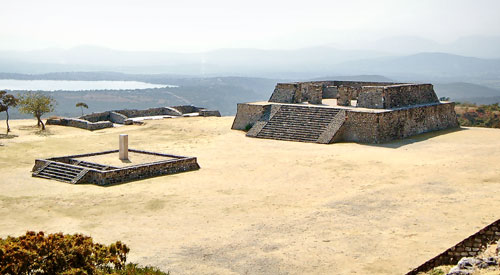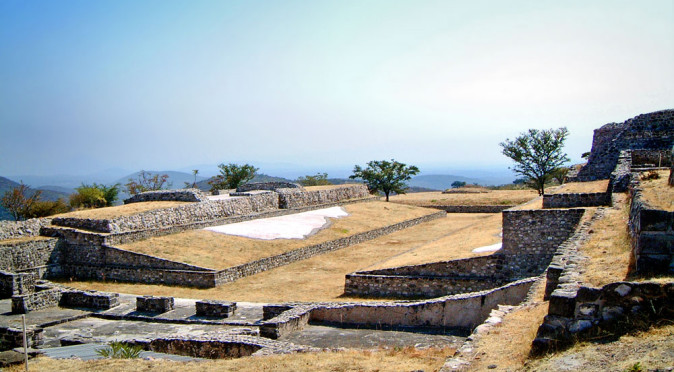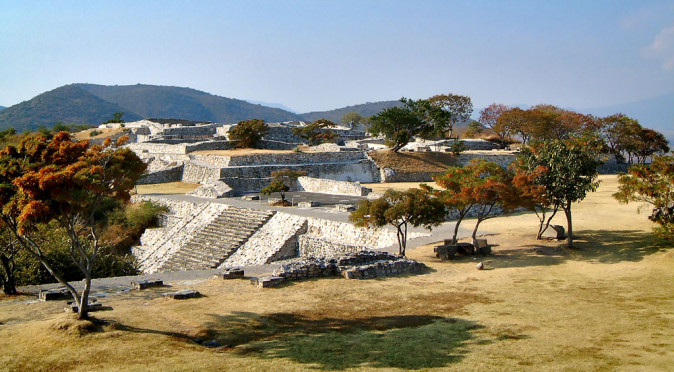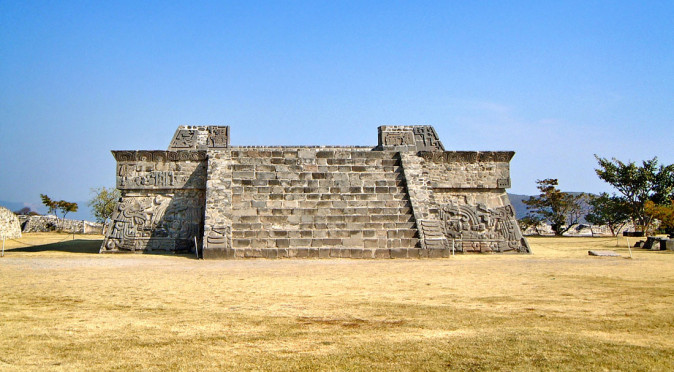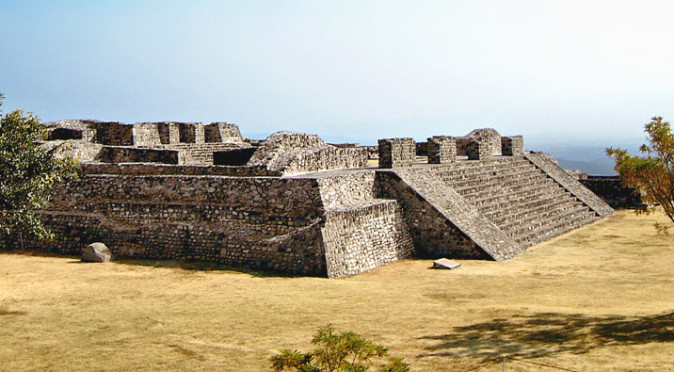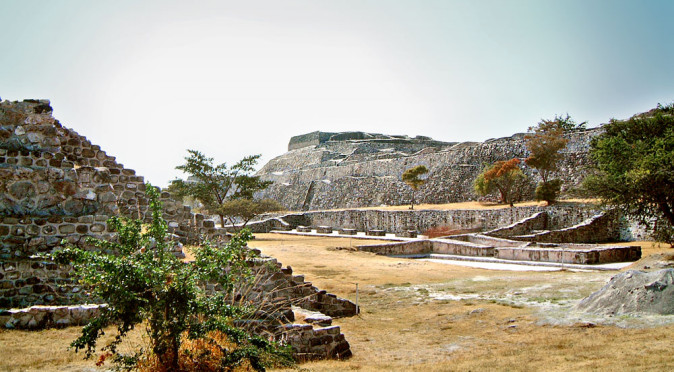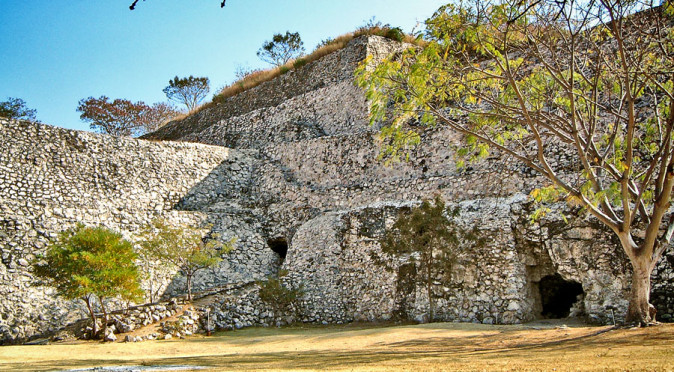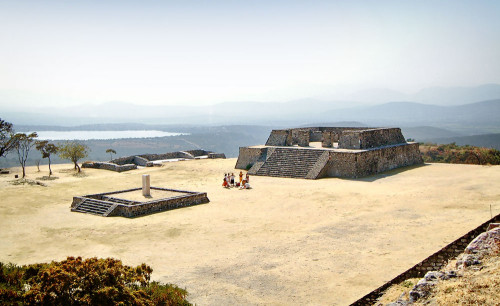
W0090: Building D – Plaza of the StelaThe Plaza of the The Stela with the Two Glyphs, known locally as the Plaza de la Estela de los Glifos, is located on terraced platform below and to the south of the main Central Plaza. The isolated Plaza features stunning views of the valley to the south and west of Xochicalco. It also provided a perfect viewing spot for observing and marking celestial events rising over the craggy hills to the east. The perfectly formed square plaza features two near identical pyramidal temple structures, one on the east side (Structure C) and the other directly opposite on the west side (Structure D), with the Grand Pyramid on the north-side. On the southern side, it appears that each of the twin pyramids had its own enclosure, which was possibly where the priests could prepare. These two pyramidal bases still have the remnants of their temple enclosures on top, which would have presumably featured wooden roofs. Unlike the Central Plaza and the Eastern Complex, the Plaza of the Two Glyphs runs strictly on an east-west / north south axis. This implies that its purpose was based around its alignment – e.g. it was for celestial observation. The two temples and the pyramid also represent the perfect trinity for rituals based around the sun, with the western temple catching the sun on its awakening in the east, the temple in the east catching the sun prior to its decent into the underworld at sunset and the pyramid ideal for marking the sun at midday as it travelled north during the summer.
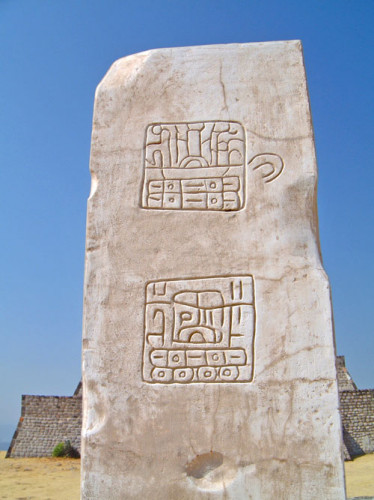
W0064: Stela of the Two GlyphsThe Stela of the Two Glyphs, which is now a faithful copy, is located at the centre of the plaza and faces east. The large base that the Stela of the Two Glyphs is mounted on has been excavated to reveal an older structure that was ritually buried – hence there is a set of stairs immediately inside a set of stairs (just about visible in fig. W0090) and in fig. W0090 you can clearly see the smaller structure nested within the outer shell). The two composite glyphs on the front read “10 Reed” and “9-Reptile-Eye”, which are both dates. The upper glyph pictures the reeds and the bottom section shows two bars, with each bar representing 5 – so a total of 10 – hence “10-Reed”. The loop to the right of this glyph is thought to symbolise a looped cord a signifies that it is a date. The lower glyph features the pictogram for “Reptile-Eye” above a bar, meaning 5, and four dots, which each equal 1, giving a total of 9. This composition does not have the looped cord, which suggests it describes an event or a person. The Aztecs used a similar glyph to represent 9-Wind, which was also the calendar name for the god Quetzalcoatl. Because this “9-Reptile-Eye” glyph is repeated on the Pyramid of the Plumed Serpents which seems almost certainly to be related to Quetzalcoatl, it is thought that the lower glyph is the Xochicalcans “cartouche” or emblem glyph for Quetzalcoatl. So it seems most likely that the stela was erected in the year “10-Reed” to honour the God Quetzalcoatl, and this may coincide with when the plaza and its structures, or possibly Xochicalco as a city, were founded.
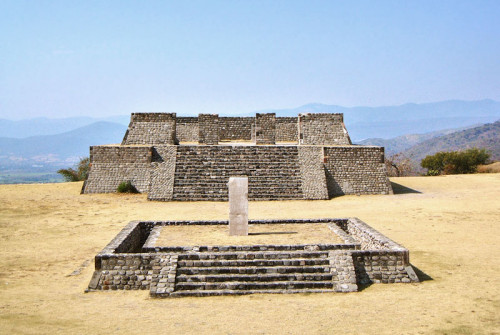
W0065: Building D and Stela of Two GlyphsThe twin pyramids bear a great likeness not only to each other, but also to the highly decorated Pyramid of the Plumed Serpents. There is one major difference though, the Pyramid of the Plumed Serpents features a protruding “tablero” and a unique angled cornice, which associates it with a very distinctive style known as talud-tablero that appears to herald from Teotihuacan. This perhaps suggests the two temples of the Plaza of the Two Glyphs, Structures C and D, pre-date the Pyramid of the Plumed Serpent, and that the distinctive style and its unique Xochicalcan adaption hadn’t been invented at the time. The Plaza of the Two Glyphs also forms the entrance to the city and its strict east-west alignment could be considered more basic than the 15º offset that the Central Plaza above exhibits – the latter demonstrates another possible link to Teotihuacan, where the mighty Avenue of the Dead shares this unusual alignment. Therefore, the humble Stela of the Two-Glyphs may mark the humble beginnings of Xochicalco, when the ceremonial core was the Plaza of the Stela and its three pyramids.
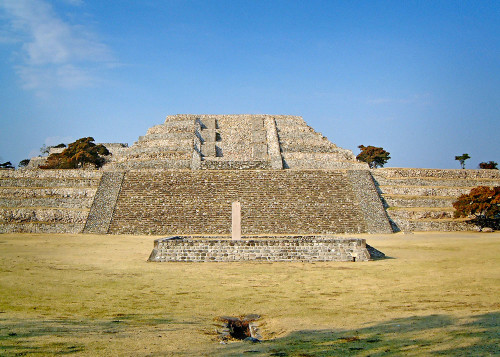
W0113: Great PyramidWhat is clear, is the the Plaza of the Two Glyphs is isolated from the main complex, high above in the Central Plaza. For on the north side of the plaza is the imposing Grand Pyramid, or Structure E. This structure rises up three levels on a huge terraced platform, and then a further four levels as a stepped pyramid. The total height is the equivalent of the upper level of Xochicalco, where the main city complex is located, but rather than bridge the gap and make it accessible from the main complex, it is left isolated, dropping all the way back to the floor where the foundations of the main city had to be built up again. Access to the main complex is via the somewhat defensive area to the left of the Great Pyramid, which features a portico with number of narrow doorways. To the right of the pyramid is the East Complex, which is similarly accessed via a porticoed gateway featuring restrictive doorways.
The result of this system is that the Plaza of the Glyphs is distinctly “outside” of the main city. This may be partly explained by a series of roads that appear to lead across the valley and merge at the Plaza of the Glyphs ceremonial centre. The evidence certainly suggests that the Plaza of the Glyphs was the original ceremonial centre and was deliberately open and welcoming to the public and that the complex built above was added by a more defensive minded group or during a more unstable period.

